RTF Focus Group Testing
Generic Clearance for Meaningful Access Information Collections (Conferences)
Focus Group RTF Testing - Scheme Prototype Protocol _Dec 2015
RTF Focus Group Testing
OMB: 1520-0009
Bureau of Engraving and Printing Tactile Feature Program:
Small Panel Interview Protocol Script
INTRODUCTION
Thank you for agreeing to answer questions about tactile features to be incorporated into future U.S. Currency. Let me tell you what this is about.
I am from the Bureau of Engraving and Printing; the BEP produces all of the nation’s paper currency, which is then issued by the Federal Reserve. The Bureau of Engraving and Printing is planning to add tactile symbols to paper money so that blind people can use their sense of touch to denominate different sample coupons, that is, determine whether the sample coupon is a $5, $10, or $20, for example. We are still doing research, trying to find the best symbols to use. I’ll be asking you to handle different samples with raised tactile symbols on them; you will be helping us by either the number or type of symbol you can identify and which are the most perceptible to you.
Paperwork Reduction Act Notifications
Before we get started, I have to provide you several notifications required under the Paperwork Reduction Act (PRA). The questions being asked and your responses constitute a collection of information that is subject to the requirements of the PRA.
The purpose of this information collection is to determine which tactile features may be the most effective in providing a means of assisting blind and visually impaired individuals in denominating U.S. paper currency.
The information provided during this collection of information will be reviewed by the BEP, the Department of The Treasury, The Federal Reserve Board, The Federal Reserve Bank – Currency Technology Office, and the US Secret Service. The information will help these agencies analyze and collaborate on what type of tactile features are most effective.
We estimate it will take 30 minutes for you to answer the questions being asked today.
You are advised that your participation is completely voluntary, there is no obligation for you to provide responses, and you can decide to end the interview at any time.
I want to assure you that the BEP is not going to collect any personally identifiable information from you today. You will not be asked your name, address, phone number, social security number, birthday, or any other information that could be used to personally identify you.
BEP will do its best to maintain your answers as non-public information. The BEP may, however, share the results of this information collection with other agencies for the purposes of tactile feature development. In addition, BEP is obligated to provide records in response to requests submitted under the Freedom of Information Act. Again, please note that no information that can identify you personally will be collected today.
BEP is obligated to inform you that today’s information collection must be conducted under a valid control number issued by the Office of Management and Budget (OMB). The information collection being conducted today has been approved by OMB pursuant to a generic approval process, under the OMB control number 1520-0009. The clearance is posted on the OMB Office of Information and Regulatory Affairs Information Collection Review Dashboard, available at www.reginfo.gov.
INTRODUCTION TO RESPONDENT TASKS
In all tasks, the interviewer will hand coupons to the respondent one at a time, with the symbols on the upward facing side, from the respondent’s perspective. The respondent will feel each coupon and state whether or not the coupon has any tactile features on it and identify either the number of features or type.
Task 1: Introductory task to familiarize the respondents with the banknotes and testing process
Today I have two sets of application methods with six scheme prototypes each. Each set will have symbols or patterns representing five currency denominations (dollar bills), the $5, $10, $20, $50, and $100. I have several different sets of these sample notes, which differ with respect to their design (symbols, patterns) and to how the designs were made. The symbols are in the form of rectangles or track lines in the upper-left corner, shapes, large raised pattern numerals and patterned side borders of the samples, which you can feel with your fingers. You are going to help us study an important question—what is the best shape or pattern and application method to make the tactile identification of currency possible?
So what I’m going to do is run you through a series of tasks with these test samples. For each task, we’ll do it several times because I’m going to be handing you different samples and asking you questions about them.
This first task is a task to get you familiar with the tactile features on the coupons. I’ll be asking you to hold a bill. When we do this, we’ll start with you holding the bill the exact same way each time. Hold this bill for a moment (interviewer hands a coupon to the respondent). When I hand you a bill, hold it with your right hand between the thumb and forefinger (pause for R to get into this position), and with your left hand, keep your thumb and forefinger on the lower corner of the bill, away from the symbols. And we’d like you to keep the bill up off of the table. This is what we call the “starting position.”
You will feel across the bill and determine if you feel raised symbols on the bill.
For this first task, I’ll give you a sample coupon to hold in the starting position. You will use your fingers to feel across the bill and determine if you feel raised symbols on the bill. When you have completed feeling the bill, I’d like you to tell me whether or not the sample coupon had any raised feature on it and if so how many. If there are two raised features I’ll ask if they were close together or separated. All right? Let’s start – here’s the first sample coupon.
[Make sure R is in the correct starting position for each trial]
Did the sample coupon have any tactile feature on it and how many? (Please say the number of tactile features or say none if the sample coupon has no tactile features on it at all).
|
Correct |
Incorrect |
Sample 1 |
|
|
Sample 2 |
|
|
Sample 3 |
|
|
Sample 4 |
|
|
Sample 5 |
|
|
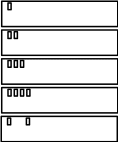
Figure 1. The configurations of the symbols on the coupons
Task 2-4: Accuracy task with stacks of coupons
In this task, the interviewer will place a stack of five coupons on the table in front of the respondent. The five coupons in the stack bear the five symbol configurations noted above Figure 1 in random order. The symbols on all five coupons in the stack will all be of the same type: intaglio/rectangle, intaglio/patterned rectangle, intaglio/track lines, intaglio/shapes, intaglio/large patterned numerals, intaglio/patterned borders, and coated embossed /rectangle, coated embossed /patterned rectangle, coated embossed /track lines, coated embossed /shapes, coated embossed /large patterned numerals, coated embossed /patterned borders that have be through the wearing (circulation simulation) process. When the respondent is ready the interviewer will say “Go” and start the timer. The respondent picks up the top coupon in the stack, feels for the symbols, reports the number of tactile features, drops the coupon, picks up the next coupon in the stack, and repeats this process until no coupons remain in the stack. The interviewer will record the respondent’s accuracy in identifying the number of symbols on each coupon and how much time elapses. The interviewer will also record the respondent’s commentary on the ease of use.
When the respondent finishes the first stack of five coupons, the interviewer will present the next stack. The interviewer will present a total of seven stacks. The first stack will be for practice, to familiarize the respondent with the task. The remaining six stacks include one each of the three types of denomination scheme tactile features from the two types of application methods.
For this task, I’ll be putting a stack of bills in front of you. Each of the bills in the stack will have 1, 2, 3 or 4 tactile features, rectangles or track lines on it. If it has 2 features, they may be close together or spaced apart.
What I’d like for you to do is pick up one bill at a time. Feel the bill any way you like, but do not hold the bill against the table. Then tell me how many symbols are on the bill and if they were spaced far apart. Do this, one bill after another, until you reach the last bill in the stack. I’d like you to do this as quickly as you can, but most importantly, I need you to be accurate too, okay? After each stack I’ll ask you to rate how easy or difficult it was. During this phase we will do this for six different stacks.
All right then, let me know when you are ready and I’ll say “Go” and I’ll start timing..
(Do this 7times: the first is a practice trial, then once for each stack. Time each stack separately. Start the timer the moment that the respondent starts. Stop the timer the moment that the respondent states the number of features on the final sample coupon in the stack. After each stack, ask the respondent to rate the difficulty on a 1-5 scale, 5- very easy and 1-very difficult.)
Practice Task-1
|
Correct |
Incorrect |
P1-1 |
|
|
P1-2 |
|
|
P1-2S |
|
|
P1-3 |
|
|
P1-4 |
|
|
Time: ____________
STACK 1 (practice): On a scale from 1 to 5, where 5 is very easy and 1 is very difficult, how easy or difficult was it to count the number of tactile features? _________
Testing Task – 1-3
Task A
|
Correct |
Incorrect |
A3 |
|
|
A4 |
|
|
A1 |
|
|
A2 |
|
|
A2S |
|
|
Time: ____________
STACK A: On a scale from 1 to 5, where 5 is very easy and 1 is very difficult, how easy or difficult was it to count the number of tactile features? _________
This will be continued and repeated for Task A through F corresponding to the Table 1 below:
Sample ID/Task |
Print Method |
Prototype Scheme |
A |
Intaglio |
Rectangle |
B |
Intaglio |
Track lines |
C |
Intaglio |
Patterned Rectangle |
D |
Coat-Emboss |
Rectangle |
E |
Coat-Emboss |
Track lines |
F |
Coat-Emboss |
Patterned Rectangle |
G |
Intaglio |
Shapes |
H |
Coat-Emboss |
Shapes |
J |
Intaglio |
Large Patterned Numerals |
K |
Coat-Emboss |
Large Patterned Numerals |
L |
Intaglio |
Patterned Borders |
M |
Coat-Emboss |
Patterned Borders |
Table 1.
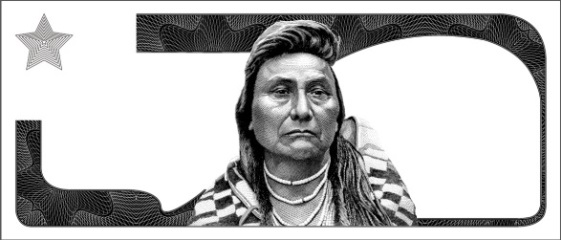


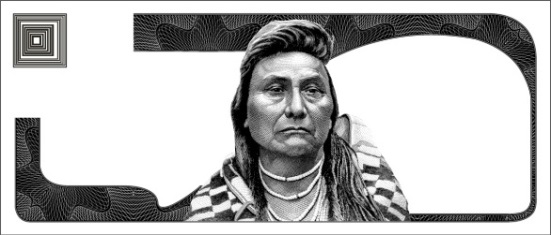

Figure 2. The configurations of the shapes on the coupons
Task 5: Accuracy task with stacks of coupons
In this task, the interviewer will place a stack of five coupons on the table in front of the respondent. The five coupons in the stack bear the five symbol configurations noted above Figure 2 in random order. The symbols on all five coupons in the stack will all be of the same type: intaglio/shapes or coated embossed /shapes which have been through the wearing (circulation simulation) process. The interviewer will conduct a familiarization practice round having each shape verified by the respondent. After that, when the respondent is ready for the testing rounds, the interviewer will say “Go” and start the timer. The respondent picks up the top coupon in the stack, feels for the symbols, reports the number of tactile features, drops the coupon, picks up the next coupon in the stack, and repeats this process until no coupons remain in the stack. The interviewer will record the respondent’s accuracy in identifying the number of symbols on each coupon and how much time elapses. The interviewer will also record the respondent’s commentary on the ease of use.
When the respondent finishes the first stack of five coupons, the interviewer will present the next stack. The interviewer will present a total of three stacks. The first stack will be for practice, to familiarize the respondent with the task. The remaining two stacks include shapes from the two types of application methods.
For this task, I’ll be putting a stack of bills in front of you. Each of the bills in the stack will have a different shape tactile feature which we will review first.
What I’d like for you to do is pick up one bill at a time. Feel the bill any way you like, but do not hold the bill against the table. Then tell me the shape on the bill. Do this, one bill after another, until you reach the last bill in the stack. I’d like you to do this as quickly as you can, but most importantly, I need you to be accurate too, okay? After each stack I’ll ask you to rate how easy or difficult it was. During this phase we will do this for three different stacks. The first will be a familiarization practice round. where I’ll identify the shape (star, circle, triangle, square, diamond) and have you verify it. Next we will do two more stacks and have you identify the shapes.
(Start with identifying each shape (star, circle, triangle, square, diamond) and hand to the respondent to verify for the practice round.)
This first symbol is a star. Tell me if you can identify it. (Provide “star” coupon to respondent to verify. Repeat for the remaining four shapes (circle, triangle, square, diamond)).
(Then proceed to the testing sample stacks G and H corresponding to Table 1 above.)
All right then, we will start the testing. Let me know when you are ready and I’ll say “Go” and I’ll start timing.
(Do this 2 times. Time each stack separately. Start the timer the moment that the respondent starts. Stop the timer the moment that the respondent states the shape on the final sample coupon in the stack. After each stack, ask the respondent to rate the difficulty on a 1-5 scale, 5- very easy and 1- very difficult.)
Practice Task-2
|
Identified |
|
P2-Star |
|
|
P2-Circle |
|
|
P2-Triangle |
|
|
P2-Square |
|
|
P2-Diamond |
|
|
Testing Task -4
Task G
|
Correct |
Incorrect |
G-Square |
|
|
G-Diamond |
|
|
G-Star |
|
|
G-Circle |
|
|
G-Triangle |
|
|
Time: ____________
STACK G: On a scale from 1 to 5, where 5 is very easy and 1 is very difficult, how easy or difficult was it to identify the shape of the tactile features? _________
Repeat for STACK H.
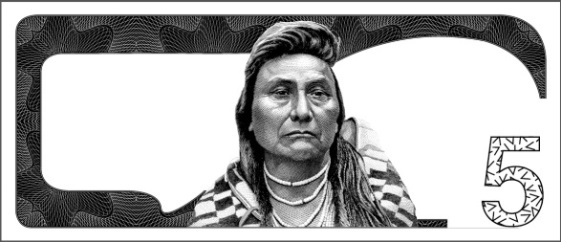
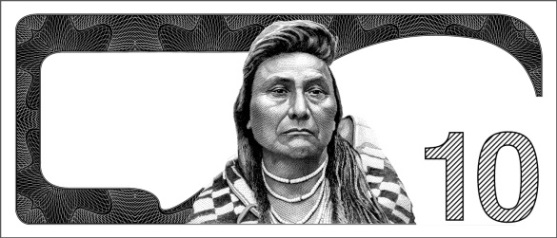
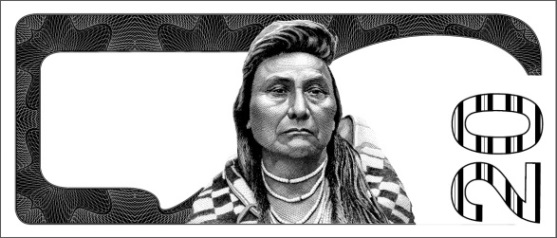
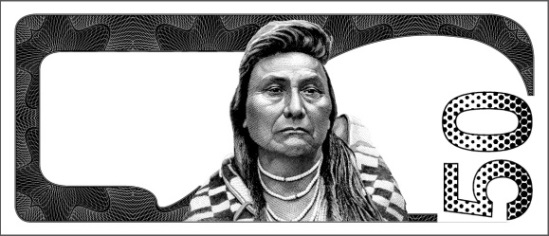
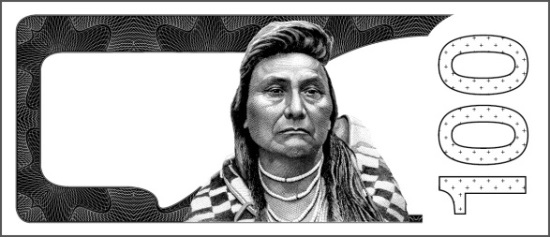
Figure 3. The configurations of the numerals on the coupons
Task 6: Accuracy task with stacks of coupons
In this task, the interviewer will place a stack of five coupons on the table in front of the respondent. The five coupons in the stack bear the five large patterned numerals noted above in Figure 3 in random order. The symbols on all five coupons in the stack will all be of the same type: intaglio/large patterned numerals or coated embossed / large patterned numerals which have been through the wearing (circulation simulation) process. The interviewer will conduct a familiarization practice round having each numeral verified by the respondent. After that, when the respondent is ready for the testing rounds, the interviewer will say “Go” and start the timer. The respondent picks up the top coupon in the stack, feels for the numeral, reports it, drops the coupon, picks up the next coupon in the stack, and repeats this process until no coupons remain in the stack. The interviewer will record the respondent’s accuracy in identifying the numeral on each coupon and how much time elapses. The interviewer will also record the respondent’s commentary on the ease of use.
When the respondent finishes the first stack of five coupons, the interviewer will present the next stack. The interviewer will present a total of three stacks. The first stack will be for practice, to familiarize the respondent with the task. The remaining two stacks include shapes from the two types of application methods.
For this task, I’ll be putting a stack of bills in front of you. Each of the bills in the stack will have a tactile feature consisting of a different large numeral (5, 10, 20, 50, 100) with a pattern on it which we will review first.
What I’d like for you to do is pick up one bill at a time. Feel the bill any way you like, but do not hold the bill against the table. Then tell me the numeral on the bill. Do this, one bill after another, until you reach the last bill in the stack. I’d like you to do this as quickly as you can, but most importantly, I need you to be accurate too, okay? After each stack I’ll ask you to rate how easy or difficult it was. During this phase we will do this for three different stacks. The first will be a familiarization practice round. where I’ll identify the numeral (5, 10, 20, 50, 100) and have you verify it. Next we will do two more stacks and have you identify the numeral.
(Start with identifying each numeral (5, 10, 20, 50, 100) and hand to the respondent to verify for the practice round.)
This first numeral is a five (5). Tell me if you can identify it. (Provide “5” coupon to respondent to verify. Repeat for the remaining four numerals(10, 20,50,100)).
(Then proceed to the testing sample stacks J and K corresponding to Table 1 above.)
All right then, we will start the testing. Let me know when you are ready and I’ll say “Go” and I’ll start timing.
(Do this 2 times. Time each stack separately. Start the timer the moment that the respondent starts. Stop the timer the moment that the respondent states the shape on the final sample coupon in the stack. After each stack, ask the respondent to rate the difficulty on a 1-5 scale, 5- very easy and 1- very difficult.)
Practice Task-3
|
Identified |
|
P3-“5” |
|
|
P3-“10” |
|
|
P3-“20” |
|
|
P3-“50” |
|
|
P5-“100” |
|
|
Testing Task -5
Task J
|
Correct |
Incorrect |
J-“10” |
|
|
J-“50” |
|
|
J- “100” |
|
|
J-“20” |
|
|
J-“5) |
|
|
Time: ____________
STACK J: On a scale from 1 to 5, where 5 is very easy and 1 is very difficult, how easy or difficult was it to identify the shape of the tactile features? _________
Repeat for STACK K.
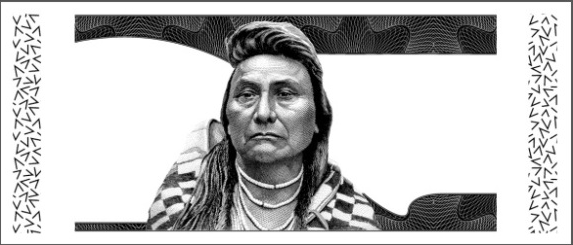
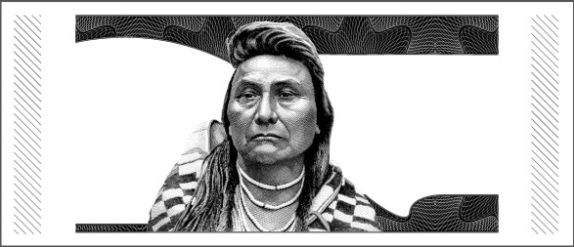
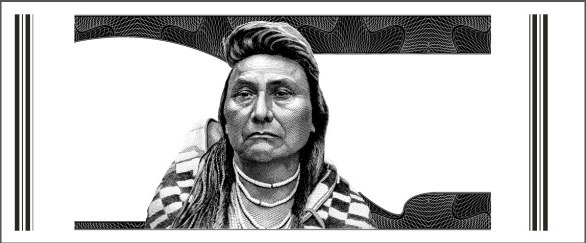
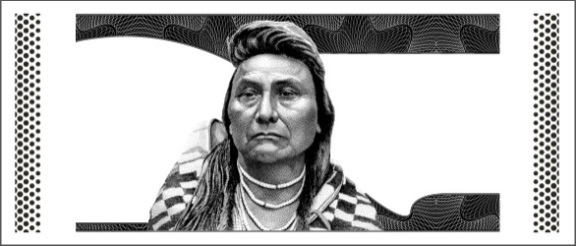
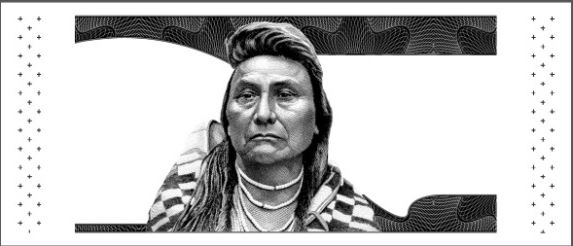
Figure 4. The configurations of the patterned borders on the coupons
Task 7: Accuracy task with stacks of coupons
In this task, the interviewer will place a stack of five coupons on the table in front of the respondent. The five coupons in the stack bear the five large patterned numerals noted above in Figure 4 in random order. The symbols on all five coupons in the stack will all be of the same type: intaglio/patterned side borders or coated embossed / patterned side borders which have been through the wearing (circulation simulation) process. The interviewer will conduct a familiarization practice round having each numeral verified by the respondent. After that, when the respondent is ready for the testing rounds, the interviewer will say “Go” and start the timer. The respondent picks up the top coupon in the stack, feels for the numeral, reports it, drops the coupon, picks up the next coupon in the stack, and repeats this process until no coupons remain in the stack. The interviewer will record the respondent’s accuracy in identifying the patterned borders on each coupon and how much time elapses. The interviewer will also record the respondent’s commentary on the ease of use.
When the respondent finishes the first stack of five coupons, the interviewer will present the next stack. The interviewer will present a total of three stacks. The first stack will be for practice, to familiarize the respondent with the task. The remaining two stacks include shapes from the two types of application methods.
For this task, I’ll be putting a stack of bills in front of you. Each of the bills in the stack will have a tactile feature consisting of different patterned side borders (random “V”s, diagonal lines, vertical lines, close dots, spaced crosses) which we will review first.
What I’d like for you to do is pick up one bill at a time. Feel the bill any way you like, but do not hold the bill against the table. Then tell me the border pattern on the bill. Do this, one bill after another, until you reach the last bill in the stack. I’d like you to do this as quickly as you can, but most importantly, I need you to be accurate too, okay? After each stack I’ll ask you to rate how easy or difficult it was. During this phase we will do this for three different stacks. The first will be a familiarization practice round. where I’ll identify the border pattern (random “V”’s, diagonal lines, vertical lines, close dots, spaced crosses) and have you verify it. Next we will do two more stacks and have you identify the border patterns.
(Start with identifying each numeral (random “V”’s, diagonal lines, vertical lines, close dots, spaced crosses) and hand to the respondent to verify for the practice round.)
This first numeral is a five (5). Tell me if you can identify it. (Provide “random “V” border pattern coupon to respondent to verify. Repeat for the remaining four border patterns (diagonal lines, vertical lines, close dots, spaced crosses)).
(Then proceed to the testing sample stacks L and M corresponding to Table 1 above.)
All right then, we will start the testing. Let me know when you are ready and I’ll say “Go” and I’ll start timing.
(Do this 2 times. Time each stack separately. Start the timer the moment that the respondent starts. Stop the timer the moment that the respondent states the shape on the final sample coupon in the stack. After each stack, ask the respondent to rate the difficulty on a 1-5 scale, 5- very easy and 1- very difficult.)
Practice Task-4
|
Identified |
|
P4-“Random “V”s |
|
|
P4-“Diagonal Lines” |
|
|
P4-“Vertical Lines” |
|
|
P4-“Close Dots” |
|
|
P4-“Spaced Crosses” |
|
|
Testing Task -5
Task L
|
Correct |
Incorrect |
L-“Close Dots” |
|
|
L-“Vertical Lines” |
|
|
L- “Random “V”s” |
|
|
L-“ Spaced Crosses” |
|
|
L-“ Diagonal Lines” |
|
|
Time: ____________
STACK L: On a scale from 1 to 5, where 5 is very easy and 1 is very difficult, how easy or difficult was it to identify the border patterns of the tactile features? _________
Repeat for STACK M.
| File Type | application/vnd.openxmlformats-officedocument.wordprocessingml.document |
| Author | Johnston Michael |
| File Modified | 0000-00-00 |
| File Created | 2021-01-24 |
© 2025 OMB.report | Privacy Policy